- Sorry, this product is unavailable.
-
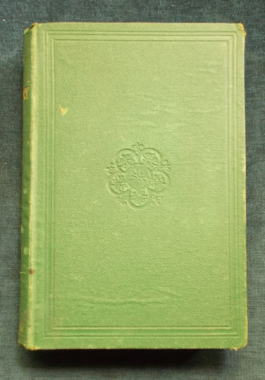
 This edition, 1866 (!) is a volume that contains 'views of the characters of the world's greatest men...and to present these views in the best words of the best authors.' One can only imagine how differently some of the greats herein may be viewed today, over a century later; would Lorenzo de Medici, for instance, be remembered as a patron of the arts or as a member of a family of notorious poisoners? In this compendium: Kings and Conquerors: Alexander the Great, Grote; Julius Caesar, de Quincey; Mahomet, Gibbon; Charlemagne, Hallam; Alfred, Hume; William the Conqueror, Lyttleton; Wallace and Robert Bruce, Tytler; Peter the Great and Charles XII, Voltaire; Charles V, Robertson; Henry VIII, Froude; Oliver Cromwell, Carlyle; Lord Clive, Macauley; Washington and Napoleon Buonaparte, Brougham; Nelson, Alison and Lamartine; Sir John Moore, Napier; Wellington, Hugh Miller. Statesmen and Orators: Cicero, Professor Spaulding; Lorenzo de Medici, Hallam; Machiavelli, Sismondi; Cardinal Wolsey, Sir Thomas More and Sir Walter Raleigh, Tytler; Thomas Cromwell, Froude; Hampden, William Pitt, Earl of Chatham, Warren Hastings and William Pitt, Macauley; Viscount Falkland, Clarendon; Burke and Charles Fox, Alison; Talleyrand, Brougham; Mirabeau and Robespierre, George Gilfillan; Palmerston, Blackwood. Philosophers And Men Of Science: Socrates, Grote; Plato, Brucker; Aristotle, Blucher; Copernicus and Kepler, Olmstead; Lord Bacon and Byron, Macauley; Galileo, Sir David Brewster; Descartes and Locke, Hallam; Sir Isaac Newtown, Voltaire; Leibnitz and Berkeley, Dugald Stewart; Benjamin Franklin and James Watt, Jeffrey; La Place, Playfair. Poets and Dramatists: Homer, Pope; Virgil and Petrarch, Professor Spaulding; Dante, Ariosto, Tasso, Lope de Vega and Alfieri, Sismondi; Chaucer, Spenser and Thomas Moore, Hazlitt; Shakespeare, Dryden-Blair; Ben Jonson, Dryden; Calderon, Augustus W. Schlegel; Cornielle, Moliére and Racine, Hallam; Milton, Congreve and Thomson, Johnson; Pope, Wordsworth and Shelley, de Quincey; Cowper, Jeffrey; Chatterton, Thomas Campbell; Burns, Carlyle; Coleridge, Foster. Historians, Novelists and Essayists: Boccaccio and Cervantes, Sismondi; Rabelais and Voltaire, Hazlitt; Montaigne and Pascal, Hallam; Swift, Jeffery; Addison, Johnson; Samuel Johnson, Sir J. Mackintosh; David Hume, Professor Nichol; Rousseau, Goethe, Schiller, John Paul Miller and Sir Walter Scott, Carlyle; Goldsmith, Johnstone; Gibbon, Prescott; DeFoe, Hugh Miller; Macaulay, George Gilfillan; Thackery, Hannay.
This edition, 1866 (!) is a volume that contains 'views of the characters of the world's greatest men...and to present these views in the best words of the best authors.' One can only imagine how differently some of the greats herein may be viewed today, over a century later; would Lorenzo de Medici, for instance, be remembered as a patron of the arts or as a member of a family of notorious poisoners? In this compendium: Kings and Conquerors: Alexander the Great, Grote; Julius Caesar, de Quincey; Mahomet, Gibbon; Charlemagne, Hallam; Alfred, Hume; William the Conqueror, Lyttleton; Wallace and Robert Bruce, Tytler; Peter the Great and Charles XII, Voltaire; Charles V, Robertson; Henry VIII, Froude; Oliver Cromwell, Carlyle; Lord Clive, Macauley; Washington and Napoleon Buonaparte, Brougham; Nelson, Alison and Lamartine; Sir John Moore, Napier; Wellington, Hugh Miller. Statesmen and Orators: Cicero, Professor Spaulding; Lorenzo de Medici, Hallam; Machiavelli, Sismondi; Cardinal Wolsey, Sir Thomas More and Sir Walter Raleigh, Tytler; Thomas Cromwell, Froude; Hampden, William Pitt, Earl of Chatham, Warren Hastings and William Pitt, Macauley; Viscount Falkland, Clarendon; Burke and Charles Fox, Alison; Talleyrand, Brougham; Mirabeau and Robespierre, George Gilfillan; Palmerston, Blackwood. Philosophers And Men Of Science: Socrates, Grote; Plato, Brucker; Aristotle, Blucher; Copernicus and Kepler, Olmstead; Lord Bacon and Byron, Macauley; Galileo, Sir David Brewster; Descartes and Locke, Hallam; Sir Isaac Newtown, Voltaire; Leibnitz and Berkeley, Dugald Stewart; Benjamin Franklin and James Watt, Jeffrey; La Place, Playfair. Poets and Dramatists: Homer, Pope; Virgil and Petrarch, Professor Spaulding; Dante, Ariosto, Tasso, Lope de Vega and Alfieri, Sismondi; Chaucer, Spenser and Thomas Moore, Hazlitt; Shakespeare, Dryden-Blair; Ben Jonson, Dryden; Calderon, Augustus W. Schlegel; Cornielle, Moliére and Racine, Hallam; Milton, Congreve and Thomson, Johnson; Pope, Wordsworth and Shelley, de Quincey; Cowper, Jeffrey; Chatterton, Thomas Campbell; Burns, Carlyle; Coleridge, Foster. Historians, Novelists and Essayists: Boccaccio and Cervantes, Sismondi; Rabelais and Voltaire, Hazlitt; Montaigne and Pascal, Hallam; Swift, Jeffery; Addison, Johnson; Samuel Johnson, Sir J. Mackintosh; David Hume, Professor Nichol; Rousseau, Goethe, Schiller, John Paul Miller and Sir Walter Scott, Carlyle; Goldsmith, Johnstone; Gibbon, Prescott; DeFoe, Hugh Miller; Macaulay, George Gilfillan; Thackery, Hannay. -
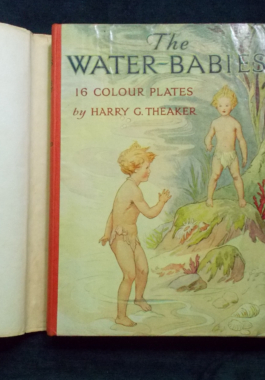
 The classic children's fantasy adventure that was first published in 1863. Tom, a poor orphan, is employed by the villainous chimney-sweep, Grimes, to climb up inside flues to clear away the soot. While engaged in this dreadful task, he loses his way and emerges in the bedroom of Ellie, the young daughter of the house who mistakes him for a thief. He runs away, and, hot and bothered, he slips into a cooling stream, falls fast asleep, and becomes a water baby. In this new life, he meets all sorts of aquatic creatures, including an engaging old lobster, other water babies, and at last reaches St Branden's Isle where he encounters the fierce Mrs Bedonebyasyoudid and the motherly Mrs Doasyouwouldbedoneby. After a long and arduous quest to the Other-End-Of-Nowhere, Tom achieves his heart's desire. Illustrated by Harry G. Theaker.
The classic children's fantasy adventure that was first published in 1863. Tom, a poor orphan, is employed by the villainous chimney-sweep, Grimes, to climb up inside flues to clear away the soot. While engaged in this dreadful task, he loses his way and emerges in the bedroom of Ellie, the young daughter of the house who mistakes him for a thief. He runs away, and, hot and bothered, he slips into a cooling stream, falls fast asleep, and becomes a water baby. In this new life, he meets all sorts of aquatic creatures, including an engaging old lobster, other water babies, and at last reaches St Branden's Isle where he encounters the fierce Mrs Bedonebyasyoudid and the motherly Mrs Doasyouwouldbedoneby. After a long and arduous quest to the Other-End-Of-Nowhere, Tom achieves his heart's desire. Illustrated by Harry G. Theaker. -
 The story of the dysfunctional and dirt-poor Walden family, headed by patriarch Ty Ty, who is firmly convinced that there is treasure buried on his land, treasure that dates back to the glory days of the clan. He is determined to find it and drives his family to dig up the entire property in a frenzied effort to find it - all except that acre that's dedicated to God and must not be touched! Made into a film with Robert Ryan and Tina Louise, well away from her ditzy Gilligan's Island role.
The story of the dysfunctional and dirt-poor Walden family, headed by patriarch Ty Ty, who is firmly convinced that there is treasure buried on his land, treasure that dates back to the glory days of the clan. He is determined to find it and drives his family to dig up the entire property in a frenzied effort to find it - all except that acre that's dedicated to God and must not be touched! Made into a film with Robert Ryan and Tina Louise, well away from her ditzy Gilligan's Island role. -

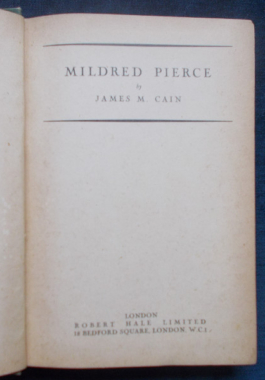 Mildred Pierce had gorgeous legs, a way with a skillet, and a bone-deep core of toughness and determination. She used those attributes to survive her husband's desertion in post-Depression America with two children and to claw her way out of poverty, becoming a successful businesswoman. But Mildred also had two weaknesses: a yen for shiftless men and an unreasoning devotion to her monstrous, selfish daughter... Made into a classic film noir starring Joan Crawford in 1945 and revisited as a miniseries in 2011 starring Kate Winslet.
Mildred Pierce had gorgeous legs, a way with a skillet, and a bone-deep core of toughness and determination. She used those attributes to survive her husband's desertion in post-Depression America with two children and to claw her way out of poverty, becoming a successful businesswoman. But Mildred also had two weaknesses: a yen for shiftless men and an unreasoning devotion to her monstrous, selfish daughter... Made into a classic film noir starring Joan Crawford in 1945 and revisited as a miniseries in 2011 starring Kate Winslet. -

 When Jerusha Abbott, an eighteen-year-old girl living in an orphan asylum, was told that a mysterious millionaire had agreed to pay for her education, it was like a dream come true. For the first time in her life, she had someone she could pretend was "family." But everything was not perfect, for he chose to remain anonymous and asked that she only write him concerning her progress in school. Who was this mysterious gentleman and would Jerusha ever meet him?
When Jerusha Abbott, an eighteen-year-old girl living in an orphan asylum, was told that a mysterious millionaire had agreed to pay for her education, it was like a dream come true. For the first time in her life, she had someone she could pretend was "family." But everything was not perfect, for he chose to remain anonymous and asked that she only write him concerning her progress in school. Who was this mysterious gentleman and would Jerusha ever meet him? -
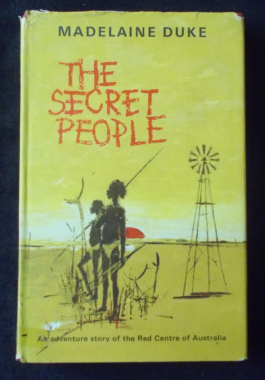 Four men set out on camel-back to cross the starkly beautiful Red Centre. Two of the men have mysterious pasts and their stories are woven into this novel that reveals dramatically the indigenous way of life. Illustrated by Mona Killpack.
Four men set out on camel-back to cross the starkly beautiful Red Centre. Two of the men have mysterious pasts and their stories are woven into this novel that reveals dramatically the indigenous way of life. Illustrated by Mona Killpack. -
 A compilation by Esquire Magazine that features the literary leading lights. In this volume: With Other Eyes, Luigi Pirandello; Turnabout Is Fair, D.H. Lawrence; Fly Away Ladybird, Conrad Aiken; Reflexshuns On Iggerunce, Ezra Pound; Exit The Boob, e.e. cummings; Arnold Pentland, Thomas Wolfe; The Celebrity, John Dos Passos; The Godly Warrior, Thomas Mann; Three Acts Of Music, F. Scott Fitzgerald; Life In A Prison Cell, Maxim Gorki; Heavenly And Earthly Love, Ferenc Molnar; The Tithe Of The Lord, Theodore Dreiser; The Butterfly And The Tank, Ernest Hemingway; Dreiser At Spoon River, Edgar Lee Masters; The Captain Is A Card, Nelson Algren; An Evening On The House, H.L. Mencken; Gentlemen, This Is Revolution, Sinclair Lewis; This Sandwich Has No Mayonnaise, J.D. Salinger; The Language Of Men, Norman Mailer; St. Francis Xavier's Bones, Evelyn Waugh; The Chinese Dog, Alberto Moravia; Brave New World Revisited, Aldous Huxley; The Case Of Arthur Miller, John Steinbeck; The Question Of Ezra Pound, Richard H. Rovers; The Misfits, Arthur Miller; Leaving The Yellow House, Saul Bellow; Letters To Alice Lockett, Bernard Shaw; Memoirs Of Mencken And Fitzgerald, George Jean Nathan.
A compilation by Esquire Magazine that features the literary leading lights. In this volume: With Other Eyes, Luigi Pirandello; Turnabout Is Fair, D.H. Lawrence; Fly Away Ladybird, Conrad Aiken; Reflexshuns On Iggerunce, Ezra Pound; Exit The Boob, e.e. cummings; Arnold Pentland, Thomas Wolfe; The Celebrity, John Dos Passos; The Godly Warrior, Thomas Mann; Three Acts Of Music, F. Scott Fitzgerald; Life In A Prison Cell, Maxim Gorki; Heavenly And Earthly Love, Ferenc Molnar; The Tithe Of The Lord, Theodore Dreiser; The Butterfly And The Tank, Ernest Hemingway; Dreiser At Spoon River, Edgar Lee Masters; The Captain Is A Card, Nelson Algren; An Evening On The House, H.L. Mencken; Gentlemen, This Is Revolution, Sinclair Lewis; This Sandwich Has No Mayonnaise, J.D. Salinger; The Language Of Men, Norman Mailer; St. Francis Xavier's Bones, Evelyn Waugh; The Chinese Dog, Alberto Moravia; Brave New World Revisited, Aldous Huxley; The Case Of Arthur Miller, John Steinbeck; The Question Of Ezra Pound, Richard H. Rovers; The Misfits, Arthur Miller; Leaving The Yellow House, Saul Bellow; Letters To Alice Lockett, Bernard Shaw; Memoirs Of Mencken And Fitzgerald, George Jean Nathan. -
 Sir Marmaduke Vane-Temperly, a man of the world who is weary of the world, goes forth to seek his vanished youth. He's cynical, pompous and ever the gentleman as befits his position. Of the many adventures that befall him, a mysterious murder is but one. He also meets Eve-Anne, a gentle, innocent 19 year old girl who on a quest for adventure and who knows him as 'John Hobbes', a gambler who cannot understand Eve-Anne's depth of generosity and feeling for those worse off than herself and her endless willingness to help them. Set in the Regency, when bucks and dandies thought it quite the adventure to meet the bruisers, vagabonds and footpads that abounded in an England that had a sharp divide between the rich and poor, the privileged and the commoners.
Sir Marmaduke Vane-Temperly, a man of the world who is weary of the world, goes forth to seek his vanished youth. He's cynical, pompous and ever the gentleman as befits his position. Of the many adventures that befall him, a mysterious murder is but one. He also meets Eve-Anne, a gentle, innocent 19 year old girl who on a quest for adventure and who knows him as 'John Hobbes', a gambler who cannot understand Eve-Anne's depth of generosity and feeling for those worse off than herself and her endless willingness to help them. Set in the Regency, when bucks and dandies thought it quite the adventure to meet the bruisers, vagabonds and footpads that abounded in an England that had a sharp divide between the rich and poor, the privileged and the commoners. -
 The Granny on the Roof-rack...and other tales of modern horror. Over 100 contemporary Australian legends reproduced just as they spread via word-of-mouth, the media, social media and the Internet. The stories range from the funny, to the bizarre and definitely to the terrifying. Told with tongue in cheek and a large grain of salt, topics included in this volume: The Baby In The Microwave; An Elephant On The Mini; The Frozen Chook At The Checkout; Kid(ney) Napping; and of course, the infamous Granny On The Roofrack.
The Granny on the Roof-rack...and other tales of modern horror. Over 100 contemporary Australian legends reproduced just as they spread via word-of-mouth, the media, social media and the Internet. The stories range from the funny, to the bizarre and definitely to the terrifying. Told with tongue in cheek and a large grain of salt, topics included in this volume: The Baby In The Microwave; An Elephant On The Mini; The Frozen Chook At The Checkout; Kid(ney) Napping; and of course, the infamous Granny On The Roofrack. -
 Hercule Poirot is vacationing on the Cornish coast when he meets Miss Buckley, the young and reckless mistress of End House, an imposing structure perched on the rocky cliffs of St. Loo. Poirot takes a particular interest in the young woman who has recently narrowly escaped a series of life-threatening accidents; he feels that these so-called accidents are more than just mere coincidences or a spate of bad luck. It seems all too clear to him that someone is trying to do away with Miss Buckley - but who? And why? In his quest for answers, Poirot must delve into the dark history of End House. The deeper he gets into his investigation, the more certain he is that the killer will soon strike again. And this time, the killer might succeed...
Hercule Poirot is vacationing on the Cornish coast when he meets Miss Buckley, the young and reckless mistress of End House, an imposing structure perched on the rocky cliffs of St. Loo. Poirot takes a particular interest in the young woman who has recently narrowly escaped a series of life-threatening accidents; he feels that these so-called accidents are more than just mere coincidences or a spate of bad luck. It seems all too clear to him that someone is trying to do away with Miss Buckley - but who? And why? In his quest for answers, Poirot must delve into the dark history of End House. The deeper he gets into his investigation, the more certain he is that the killer will soon strike again. And this time, the killer might succeed... -
 Adrienne was the beautiful beloved bride of Vincent, Lord Satan, eager to begin her new life as mistress of Castle Caudill. From the moment she enters Castle Caudill, Adrienne is drawn into a world of demonic terror. Does she participate in satanic rituals and black masses or are they only horrifying dreams? Is her husband a devil with great powers at his command? And why does the ghost of Lord Satan's mother mournfully roam the halls of the castle? Desperately Adrienne sought the fearful truth, through shadows that concealed nightmarish terrors, in a world that cloaked dark unseen forces she was powerless to control...Cover art by Enrich Torres-Prat. Roberts, daughter of an Ohio missionary, was a hardworking librarian by day, devil-romancer...most likely also by day. Somewhat maligned by later romance historians for her undeniably violent sex scenes, Roberts was something of a pioneer in her context and milieu in bringing a hefty amount of explicitly disreputable sexuality to the gothic genre of the 1970s. The Louisa Bronte heroine would follow her libido to hell and beyond and the consequences be damned!
Adrienne was the beautiful beloved bride of Vincent, Lord Satan, eager to begin her new life as mistress of Castle Caudill. From the moment she enters Castle Caudill, Adrienne is drawn into a world of demonic terror. Does she participate in satanic rituals and black masses or are they only horrifying dreams? Is her husband a devil with great powers at his command? And why does the ghost of Lord Satan's mother mournfully roam the halls of the castle? Desperately Adrienne sought the fearful truth, through shadows that concealed nightmarish terrors, in a world that cloaked dark unseen forces she was powerless to control...Cover art by Enrich Torres-Prat. Roberts, daughter of an Ohio missionary, was a hardworking librarian by day, devil-romancer...most likely also by day. Somewhat maligned by later romance historians for her undeniably violent sex scenes, Roberts was something of a pioneer in her context and milieu in bringing a hefty amount of explicitly disreputable sexuality to the gothic genre of the 1970s. The Louisa Bronte heroine would follow her libido to hell and beyond and the consequences be damned! -
 How did Max Krilich get to meet the Killer Rabbit? Why was Andy Gregory glad to get the hell out of Australia? Who was the Man in the Bowler Hat? How did Ronny Gibbs get on Sale of the Century? What was Johnny Raper doing in ladies underwear...and what was the miracle at Lang Park? How did Fatty Vautin save Steve Mortimer's life? What did Freddie Jones say that shocked the PM? And what was Allan Langer doing in the USA with all those big oily men??? The answers to these and many more questions are all here in the most hilarious collection of sporting stories ever assembled in Australia. Cartoons by Scott Rigney.
How did Max Krilich get to meet the Killer Rabbit? Why was Andy Gregory glad to get the hell out of Australia? Who was the Man in the Bowler Hat? How did Ronny Gibbs get on Sale of the Century? What was Johnny Raper doing in ladies underwear...and what was the miracle at Lang Park? How did Fatty Vautin save Steve Mortimer's life? What did Freddie Jones say that shocked the PM? And what was Allan Langer doing in the USA with all those big oily men??? The answers to these and many more questions are all here in the most hilarious collection of sporting stories ever assembled in Australia. Cartoons by Scott Rigney. -
 Red - or Green? Shirley Grey; A Bit Of History, D. Dike; The Thing That Mattered, E.L. Haverfield; Improve Your Tennis, Jane Thornicroft; Letitia's Taxi Cab and Miss Connington In Town, Alice Massie; The Chinese Vase, Brenda Girvin; The Three Belpennys, Elizabeth Whitely; The Gargoyle and An Adventure In The Roussillon, S.M. Hills; Caroline And The Count, Jocelyn Oliver; The Pewter Candlestick, Dorothea Moore; S.O.S., Thura Lifford; Gillian's Choice, Pamela Tynan Hickson; Cricket For Girls, Marjorie Pollard; The Strange Sedan, M.A. Peart; It Flowered For Me Alone, Thora Stowell; The Saving Of The Undine, Beryl Irving; The Smugglers Of Portincross, Dorita Fairlie Bruce.
Red - or Green? Shirley Grey; A Bit Of History, D. Dike; The Thing That Mattered, E.L. Haverfield; Improve Your Tennis, Jane Thornicroft; Letitia's Taxi Cab and Miss Connington In Town, Alice Massie; The Chinese Vase, Brenda Girvin; The Three Belpennys, Elizabeth Whitely; The Gargoyle and An Adventure In The Roussillon, S.M. Hills; Caroline And The Count, Jocelyn Oliver; The Pewter Candlestick, Dorothea Moore; S.O.S., Thura Lifford; Gillian's Choice, Pamela Tynan Hickson; Cricket For Girls, Marjorie Pollard; The Strange Sedan, M.A. Peart; It Flowered For Me Alone, Thora Stowell; The Saving Of The Undine, Beryl Irving; The Smugglers Of Portincross, Dorita Fairlie Bruce. -
 A treasure-trove of picture-stories and written stories, in colour and black and white. There's mysteries and secrets, heroic adventures and holidays, school stories and quizzes for pre- and early teen girls.
A treasure-trove of picture-stories and written stories, in colour and black and white. There's mysteries and secrets, heroic adventures and holidays, school stories and quizzes for pre- and early teen girls. -
 The daughter of Queen Hippolyta, Diana is raised on the hidden island of Themyscira, home to the Amazons, women warriors created by the Olympian gods to protect mankind. Diana is raised on their history and knows that Ares became so jealous of humanity that he slayed the Gods and determined to destroy Mankind. But Zeus left weapons in the guardianship of the Amazons - the sword Godkiller and the Lasso of Hestia, a magical artefact that forces the truth from captives. In 1918, Diana rescues US pilot Captain Steve Trevor when his plane crashes off the Themysciran coast. The island is soon invaded by German soldiers in pursuit of Steve. The Amazons kill the crew and Steve is interrogated with the Lasso of Hestia. He reveals that a great war is consuming the outside world and that he is an Allied spy. He has stolen a notebook from the Germans' chief chemist, Dr. Isabel Maru, who is attempting to engineer a deadlier form of mustard gas under the orders of General Erich Ludendorff. Believing Ares to be responsible for the war, Diana dons her armour and must leave Themyscira with Steve to locate and stop Ares for good. Her only weapons are her Amazon training, the Lasso of Hestia and Godkiller...
The daughter of Queen Hippolyta, Diana is raised on the hidden island of Themyscira, home to the Amazons, women warriors created by the Olympian gods to protect mankind. Diana is raised on their history and knows that Ares became so jealous of humanity that he slayed the Gods and determined to destroy Mankind. But Zeus left weapons in the guardianship of the Amazons - the sword Godkiller and the Lasso of Hestia, a magical artefact that forces the truth from captives. In 1918, Diana rescues US pilot Captain Steve Trevor when his plane crashes off the Themysciran coast. The island is soon invaded by German soldiers in pursuit of Steve. The Amazons kill the crew and Steve is interrogated with the Lasso of Hestia. He reveals that a great war is consuming the outside world and that he is an Allied spy. He has stolen a notebook from the Germans' chief chemist, Dr. Isabel Maru, who is attempting to engineer a deadlier form of mustard gas under the orders of General Erich Ludendorff. Believing Ares to be responsible for the war, Diana dons her armour and must leave Themyscira with Steve to locate and stop Ares for good. Her only weapons are her Amazon training, the Lasso of Hestia and Godkiller... -

 A wonderful, charming book on the flowers and gardens of Japan - not just any tourist book, but one which also discloses the spirituality behind Japanese garden plans and why they are planned as they are. It was published in 1908 and has fifty beautiful colour illustrations. (See gallery photos for artwork examples) From Chapter II: Stones, Garden Ornaments and Fences. Stones and rocks are such important features in all Japanese gardens that when choosing the material for the making of a landscape garden, however large or however small, the selection of the stones would appear to be the primary consideration. Their size must be in perfect proportion with the house and grounds which they are to transform into a natural landscape, and they will give the scale for all the other materials used - the lanterns, bridges, and water-basins, and even the trees and fences. Their number may vary from five important stones to as many as 138, each with its especial sense and function. I think the correct position and placing of the stones is the part of the art which it would be most difficult for a foreigner to accomplish: the mere names and special functions of the stones would require years of careful study. To the eye of a Japanese one stone wrongly placed would upset all the balance and repose of the picture. Large rocks and boulders seem to be essential for the success of a large garden, and are used to suggest mountains, hills, and the rocks of the natural scene; any very fantastic and artificial looking rocks are avoided, for fear they should give an appearance of unreality to the landscape. The fancy of giving sex to certain stones, and in temple grounds of assigning holy attributes and even of giving them the names of Buddhist deities, dates from very early days, and this custom of applying a religious meaning to the most important rocks survives to this day. Mr. Conder tells us that "formerly it was said that the principal boulders of a garden should represent the Ku, or Nine Spirits of the Buddhist pantheon, five being of standing and four of recumbent..."
A wonderful, charming book on the flowers and gardens of Japan - not just any tourist book, but one which also discloses the spirituality behind Japanese garden plans and why they are planned as they are. It was published in 1908 and has fifty beautiful colour illustrations. (See gallery photos for artwork examples) From Chapter II: Stones, Garden Ornaments and Fences. Stones and rocks are such important features in all Japanese gardens that when choosing the material for the making of a landscape garden, however large or however small, the selection of the stones would appear to be the primary consideration. Their size must be in perfect proportion with the house and grounds which they are to transform into a natural landscape, and they will give the scale for all the other materials used - the lanterns, bridges, and water-basins, and even the trees and fences. Their number may vary from five important stones to as many as 138, each with its especial sense and function. I think the correct position and placing of the stones is the part of the art which it would be most difficult for a foreigner to accomplish: the mere names and special functions of the stones would require years of careful study. To the eye of a Japanese one stone wrongly placed would upset all the balance and repose of the picture. Large rocks and boulders seem to be essential for the success of a large garden, and are used to suggest mountains, hills, and the rocks of the natural scene; any very fantastic and artificial looking rocks are avoided, for fear they should give an appearance of unreality to the landscape. The fancy of giving sex to certain stones, and in temple grounds of assigning holy attributes and even of giving them the names of Buddhist deities, dates from very early days, and this custom of applying a religious meaning to the most important rocks survives to this day. Mr. Conder tells us that "formerly it was said that the principal boulders of a garden should represent the Ku, or Nine Spirits of the Buddhist pantheon, five being of standing and four of recumbent..." -

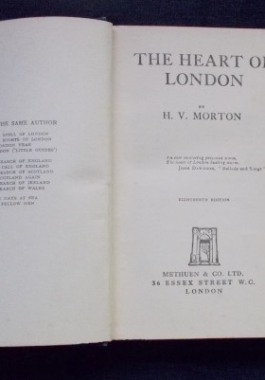 A collection of some of H.V. Morton's columns for the Daily Express, which is still in print today almost 100 years later. Morton never did the tourist route; instead he went off the beaten track to look into what really made a city. What he found was London's wonderful diversity of people against intriguing backgrounds. Among other places, he visits the docks, the Caledonian Market, Petticoat Lane, the Free Cancer Hospital, observes the nannies and their charges in Kensington Gardens, tea-shops, St. Martin's-in-the-Fields, the Lost Property Office and many other places.
A collection of some of H.V. Morton's columns for the Daily Express, which is still in print today almost 100 years later. Morton never did the tourist route; instead he went off the beaten track to look into what really made a city. What he found was London's wonderful diversity of people against intriguing backgrounds. Among other places, he visits the docks, the Caledonian Market, Petticoat Lane, the Free Cancer Hospital, observes the nannies and their charges in Kensington Gardens, tea-shops, St. Martin's-in-the-Fields, the Lost Property Office and many other places. -
 Stories include: Pandora the Prig, Peggy Carr; Out Of Bounds, A.E. Seymour; The Girl Who Had Too Many Friends, Mary Gervaise; Christmas At The Towers, M.C. Field; A Mixed Scent, Bessie Marchant; The Spies, Grace Golden; Out On Ben Corrig, Nancy Firle. With colour and black and white illustrations.
Stories include: Pandora the Prig, Peggy Carr; Out Of Bounds, A.E. Seymour; The Girl Who Had Too Many Friends, Mary Gervaise; Christmas At The Towers, M.C. Field; A Mixed Scent, Bessie Marchant; The Spies, Grace Golden; Out On Ben Corrig, Nancy Firle. With colour and black and white illustrations. -
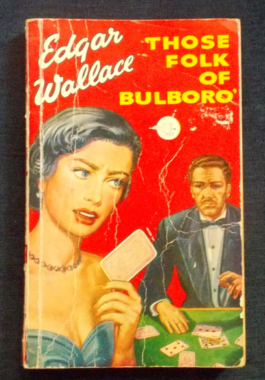 A drama takes place in a small town in Northern England following the life of a young doctor who has returned from the Congo to take over his uncle's practice. Very likely to have been based on Wallace's own time in the Congo reporting on the brutality and violence of Belgian colonialism, this novel follows the young doctor as he fights the intolerance, ignorance and religious fanaticism of his local townsfolk.
A drama takes place in a small town in Northern England following the life of a young doctor who has returned from the Congo to take over his uncle's practice. Very likely to have been based on Wallace's own time in the Congo reporting on the brutality and violence of Belgian colonialism, this novel follows the young doctor as he fights the intolerance, ignorance and religious fanaticism of his local townsfolk. -

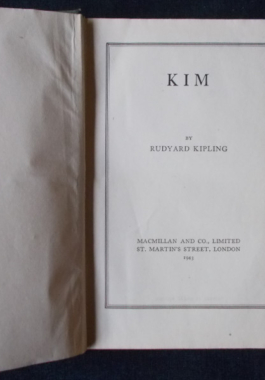
Kim: Rudyard Kipling
$25.00Set in 19th century India, this is the tale of Kim - Kimball O'Hara - the orphaned son of an Irish soldier and a poor Irish mother who have both died in poverty. Living a vagabond existence in an India under British rule, Kim earns his living by begging and running small errands on the streets of Lahore. He befriends an aged Tibetan lama and accompanies him on a spiritual journey. He is also recruited by a native member of the British secret services as a spy but he is recognised by his late father's regimental chaplain and is sent to a good English school. Kim maintains contact with his secret service friends - and he will not only learn to serve his country, but also will learn to fulfil the lama's and his own dream of Enlightenment. -
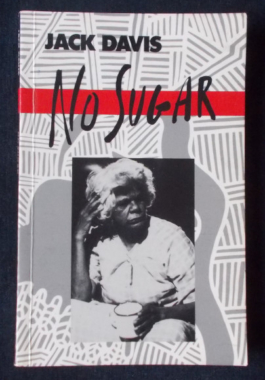
No Sugar: Jack Davis
$20.00A spirited and internationally acclaimed play set in the 1930s during the Great Depression. It tells the story of an Aboriginal family, the Millimurras. who removed from their home and forced to work on the Moore River Native Settlement. The Millimurra family take a stand against the Government's 'protection' of 1930s Australia - the Chief Protector, A.O. Neville believed at that time that 'the native must be helped in spite of himself.' Published in 1986, academics consider it an effort to validate the importance of Aboriginal culture, while also communicating the feelings of isolation when people cannot understand their own language and cultural customs. It received the Australian Writers Guild Award (AWGIE) for best stage play. -
 Former psychiatric nurse turned comedienne Jo Brand, best known here for her appearances on QI and Getting On, does not hold back on her opinions of men and the balls-up they've made of the world. No-one escapes - From Henry VIII to Mao Zedong to Elvis Presley, everyone gets equal roasting. On Sid Vicious: They had their own special language, which involved the use of phrases like, 'F*** off, you tosser,' particularly if they liked someone...On Martin Luther: Being declared a heretic in those days wasn't a barrel of laughs - it didn't take much for you to be playing the starring kebab role. On Rasputin: ...hair greasy enough to fry an egg on, eyes that would have been at home in Marty Feldman's face and a tunic that could make it back to Siberia on its own...' There's plenty of Jo Brand's particular brand of irreverent wryness to shock you into laughs.
Former psychiatric nurse turned comedienne Jo Brand, best known here for her appearances on QI and Getting On, does not hold back on her opinions of men and the balls-up they've made of the world. No-one escapes - From Henry VIII to Mao Zedong to Elvis Presley, everyone gets equal roasting. On Sid Vicious: They had their own special language, which involved the use of phrases like, 'F*** off, you tosser,' particularly if they liked someone...On Martin Luther: Being declared a heretic in those days wasn't a barrel of laughs - it didn't take much for you to be playing the starring kebab role. On Rasputin: ...hair greasy enough to fry an egg on, eyes that would have been at home in Marty Feldman's face and a tunic that could make it back to Siberia on its own...' There's plenty of Jo Brand's particular brand of irreverent wryness to shock you into laughs. -
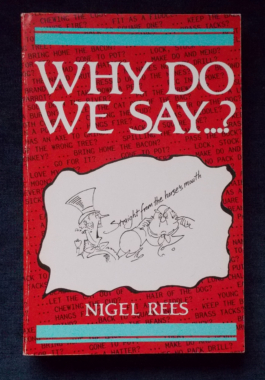 We often use expressions without thinking about it, but why do we use them and what are their origins? Such as cheesed off to denote irritation; and what does it mean to cock a snook? Why a kangaroo court? All these and so much more, great potential for trivia nights. A great little volume to browse now and then.
We often use expressions without thinking about it, but why do we use them and what are their origins? Such as cheesed off to denote irritation; and what does it mean to cock a snook? Why a kangaroo court? All these and so much more, great potential for trivia nights. A great little volume to browse now and then. -
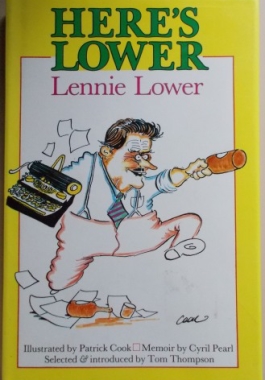
Here’s Lower: Lennie Lower
$20.00Lower only wrote the one novel, Here's Luck, in which Gudgeon and Son battle the great Australian icons - the police, the wife, the booze and the races. Here is a selection of his whimsical newspaper columns of the 1930s, short tales which were a showcase for Lower's natural Aussie anarchy. You can get the low-down on Banking; The Cruel Tactics of the Emu; The Terrors of Wealth; The Perils of the Bathtub and What Bread Is and How To Use It among other wits and wisdoms on life. -
 Inspired by real events. The story of the secret Israeli squad assigned to track down and assassinate the 11 Palestinians believed to have planned the 1972 Munich massacre of 11 Israeli athletes - and the personal toll on the team and the man who led it.
Inspired by real events. The story of the secret Israeli squad assigned to track down and assassinate the 11 Palestinians believed to have planned the 1972 Munich massacre of 11 Israeli athletes - and the personal toll on the team and the man who led it. -
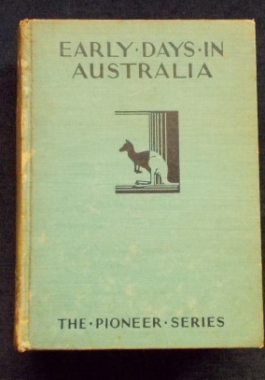 A collection of writings by various authors detailing the search for the Great Southland Terra Australis dating from accounts as far back as the 1400s. In this volume: The Early Voyagers, William Howitt; The Voyage Of Luis De Torres, R.H. Major; The Voyage of Francis Pelsart, John Pinkerton; The Voyage of Tasman, from Dr Lardner's Cabinet Cyclopædia; The Wreck Of The Vergulde Draeck, R.H. Major; In Search Of A Wreck, Matthew Flinders; Dampier And The Buccaneers, Samuel Bennett; First Voyage Of Captain Cook, Roderick Flanagan; The Voyage Of Captain Marion, Matthew Flinders; The Voyage Of Captain Furneaux, Reverend J.E.T. Woods; La Perouse, And The Voyages In Quest Of Him, William Howitt; The Voyages Of Bass And Flinders, from Dr Lardner's Cabinet Cyclopædia; Founding A Country, Roderick Flanagan; Troubles With The Natives, Samuel Bennett; Captain John Hunter In New South Wales, Samuel Bennett; John Batman And The Settlement Of Port Phillip, from Batman's Journal; The Story Of William Buckley, William Westgarth; An Emigrant's Adventures, Anonymous; In The Goldfields, Kinahan Cornwallis.
A collection of writings by various authors detailing the search for the Great Southland Terra Australis dating from accounts as far back as the 1400s. In this volume: The Early Voyagers, William Howitt; The Voyage Of Luis De Torres, R.H. Major; The Voyage of Francis Pelsart, John Pinkerton; The Voyage of Tasman, from Dr Lardner's Cabinet Cyclopædia; The Wreck Of The Vergulde Draeck, R.H. Major; In Search Of A Wreck, Matthew Flinders; Dampier And The Buccaneers, Samuel Bennett; First Voyage Of Captain Cook, Roderick Flanagan; The Voyage Of Captain Marion, Matthew Flinders; The Voyage Of Captain Furneaux, Reverend J.E.T. Woods; La Perouse, And The Voyages In Quest Of Him, William Howitt; The Voyages Of Bass And Flinders, from Dr Lardner's Cabinet Cyclopædia; Founding A Country, Roderick Flanagan; Troubles With The Natives, Samuel Bennett; Captain John Hunter In New South Wales, Samuel Bennett; John Batman And The Settlement Of Port Phillip, from Batman's Journal; The Story Of William Buckley, William Westgarth; An Emigrant's Adventures, Anonymous; In The Goldfields, Kinahan Cornwallis. -

Boys’ Annual: Collins
$20.00Short stories, tales, articles and features for teenage boys. Illustrated. In this volume: A Day In October, Edward Boyd; Gabriel's Horn, Paul Gardiner; Bunst's Good Turn, John Newtown Chance; The Ear Of Lieutenant Banzai, Hugh Paterson; Tarf The Terrible, David Stephen; The Black Horse, Jim Kjelgaard; The Rasp And The Rope, Jane Oliver; All For Madam Wonko, Captain Frank Knight; The Mystery Of The Devil's Hoofmarks, Trevor Holloway; Roly Dawson's Quiet Holiday; Have You A Puppy? David Stephen; Dave Garratt And The Space Pirates; Ship Parade; Let's Go Sailing, Thomas Muir.


